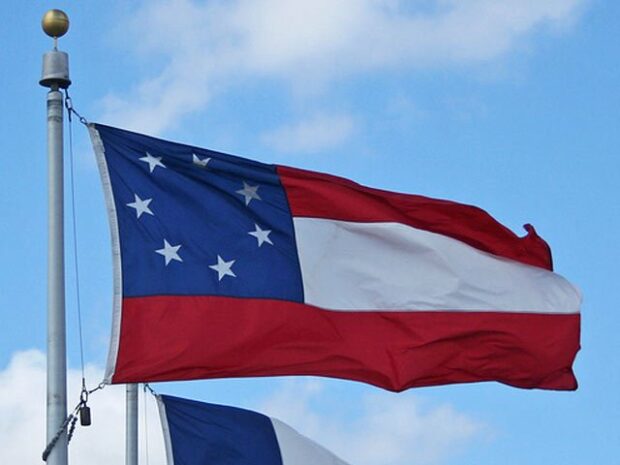What to Know about “Stars And Bars” Confederate National Flag?
The Stars and Bars Flag is the first official flag of the Confederacy. Though as compared to the Confederate Battle Flags, stars and bars were less known, this first flag was used as the official flag of the Confederacy from March 5, 1861, to May 26, 1863.
However, when the war started, the Stars and Bars confused the battlefield. It was because the flag’s design was similar to the flag Stars and Stripes of the Union forces.


What is the Significance of Seven Stars?
The seven stars on the first confederate flag speak of the original Confederate States:
- South Carolina (December 20, 1860)
- Mississippi(January 9, 1861)
- Florida (January 10, 1861)
- Alabama (January 11, 1861)
- Georgia (January 19, 1861)
- Louisiana (January 26, 1861)
- Texas (February 1, 1861)
The first public appearance of this flag was outside the Ben Johnson House in Bardstown, Kentucky. And now the flag officially possesses 13 stars, having been joined by four more states:
- Virginia (April 17, 1861)
- Arkansas (May 6, 1861)
- Tennessee (May 7, 1861)
- North Carolina (May 21, 1861)
Guidelines to Follow Before You Display a Flag
As a patriot, you want to show your love and respect for your country by displaying a confederate flag. But, remember that Public Law 94-344, known as the Federal Flag Code, has specified the rules related to handling and displaying the U.S. flag.
Though the federal code has no penalties for misusing the flag, states possess their flag codes and can impose penalties. The federal code language makes it clear that the confederate flag is a living symbol.
Moreover, in response to a Supreme Court decision that held a state law prohibiting flag burning was unlawful, Congress passed the Flag Protection Act in 1989. It mentions that you may get fined or even imprisoned for up to one year if you knowingly insult the flag. However, in a 1990 decision, the Supreme Court challenged this law that the Flag Protection Act disrupts the First Amendment free speech protections.
Things You Should Remember
- According to traditional-guidelines, you can display Stars and Bars Flag in public only from sunrise to sunset. However, you can display the confederate flag at all times only if the flag is illuminated during darkness.
- Your flag should not be subject to any weather damage; hence you should not display your flag during snow, rain, and violent wind storms unless the flag is an all-weather flag.
- You can display your flag often, but mainly on national and state holidays along with special occasions.
What are the Best Ways You Can Display the Flag?
Flying the stars and bars for the first time? Well, you can show proper respect to your nation only when you display your confederate flag in the right place.
The Flag Position
Be careful about the position of the union (the blue colored field) of your flag. When displaying the confederate flag horizontally or at an angle from the front of your building, keep the union area of the flag on the top of the staff, unless your flag is at half-staff.
If you display your flag against a wall or in a window, the blue area should be on the top and the right of the flag. Occasionally, on the President’s order, you can flow the flag at half-staff. It is usually upon the death of prominent members of the government as a token of respect to their memory. When you display your flag at half-staff, raise it to the top for an instant and lower it to the half-staff position.
Similarly, just before you lower the flag for the day, once again, you must hoist the flag momentary to the peak. You can position the flag at half-staff by placing the flag one-half the distance between the staff’s bottom and top.
In case you are confused about how you can display the flag vertically, never display the stars and stripes flag with the union (blue field) down. However, you can place the flag in this position only when it is a sign of extreme distress, like a danger to property or life.
Finally, there are many historical U.S. flags that you can display as long as they are in good condition. No matter if it’s indoors or outdoors, you must follow proper rules to place the flag freely. But if you choose the historical U.S. flags, you must also treat them with the same respect and rituals as the official flag.
To sum up, it is good to embrace the Stars and Bars Flag in your life. However, it can be specifically crucial to fly your flag on important-dates like Independence Day.